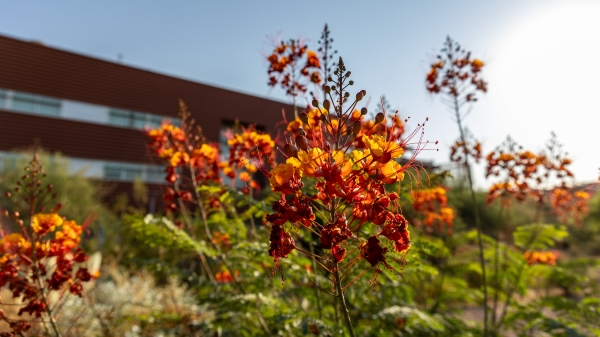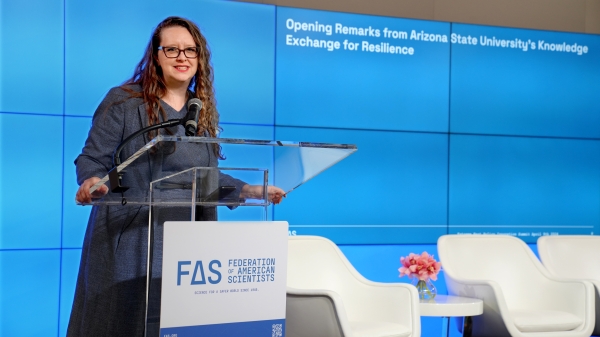Professor leads by pursuing science without boundaries

ASU professor Janet Franklin joins just 11 other faculty at ASU who are members of the American Academy of Arts and Sciences.
Janet Franklin has had quite a year: After having been elected to the National Academy of Sciences two years ago, in June 2015 she was selected as an Arizona State University Regents' Professor and also as a Fellow of the Ecological Society of America. In November 2015, she was elected to the American Association for the Advancement of Science.
On April 19, Franklin received notification of one more recognition — she joins just 11 other faculty at ASU who are members of the American Academy of Arts and Sciences. The American Academy, as the organization is known, was founded in 1780 and includes notable members from Benjamin Franklin, Thomas Jefferson and John Adams to Nelson Mandela, Georgia O’Keeffe, Margaret Meade and Albert Einstein.
This mix of leaders are a fitting group of peers for Franklin, whose research bridges the academic disciplines of geography and biology, and who collaborates with scientists in a wide assortment of other disciplines.
Franklin’s work focuses on the dynamics of land-based plant communities. Plant communities are impacted by a complex web of factors — from natural forces like fire to human impacts like introduction of non-native species and clearing of land. Looking at variations over decades and centuries, changes in precipitation, temperature and other aspects of climate clearly impact vegetation also.
Buffeted by all these forces, some ecosystems and species decline, and others survive. Franklin’s work focuses on understanding how the various factors interact with each other to create unique responses to change.
From her early years as a scientist, Franklin has investigated these questions by innovative use of geographic data such as earth images collected by satellites, together with analytic tools that tease out unique spatial patterns and how they vary over time and space.
Given the innovative techniques that she’s pioneered, Franklin has collaborated with a diverse group of scientists — and her collaborators are quick to mention her ability to work across disciplinary boundaries.
“Janet Franklin epitomizes the modern interdisciplinary scientist,” said David Steadman, curator of ornithology at the Florida Museum of Natural History. Steadman works with Franklin on investigating the long-term impacts of human and natural disturbance on tropical forest island ecosystems in the Caribbean.
“Franklin collaborates creatively and very effectively with an amazing array of ecologists, botanists, zoologists, paleontologists, and archaeologists, not to mention geographers of every sort. Through a combination of modern methods and a good deal of common sense, Janet enriches research projects around the world,” Steadman added.
Another of Franklin’s current efforts explores interrelations between climate, environment and human origins in southern Africa over many millennia. The project is led by Curtis Marean, professor in ASU’s School of Human Evolution and Social Change.
“The project includes a wide diversity of scientists from many ‘cultures’ of nation and science, and keeping things together can be a challenge,” said Marean. “Janet is a dream to work with — always supportive, helpful and flexible. She helps us work as a team, while at the same time bringing an incredible intellectual game.”
Julie Ripplinger, a postdoctoral student under Franklin, said, “I came to Arizona State University to work with Janet for my PhD when she inspired me to push the boundaries of conventional ecological studies and answer questions about why and how urban plant diversity is changing in the long-term.
“Janet has long been my mentor and champion. Janet continues to inspire me as a woman in science and to challenge me to excel as a scholar.”
Franklin will be inducted into the American Academy of Sciences on Oct. 8 at the Academy’s headquarters in Cambridge, Massachusetts.
Once a member of the academy, Franklin will have opportunities to participate in the organization’s work in policy research. Members contribute to Academy publications and studies of science and technology policy, energy and global security, social policy and American institutions, the humanities and culture, and education.
“Janet Franklin’s accomplishments bring honor and recognition to ASU, our school and to the geographical profession. I personally am in awe of Janet’s achievements, said Patricia Gober, interim director of the School of Geographical Sciences and Urban Planning. “Speaking for the faculty, we are enormously proud to have her as a colleague.”
Curtis Marean is Foundation Professor in the School of Human Evolution and Social Change and is associate director of the Institute of Human Origins. The School of Geographical Sciences and Urban Planning and School of Human Evolution and Social Change are units of the College of Liberal Arts and Sciences.
More Environment and sustainability

Barrett Honors College to host nature walks for science, relaxation
Barrett, The Honors College at Arizona State University is gearing up to participate in the City Nature Challenge (CNC) for the…

Arizona adapting to heat crisis with initiatives featured in ASU report
Arizona State University's Knowledge Exchange for Resilience, also known as KER, released its Recommendations Report on Extreme…

Celebrating Earth Day around the world
Originating in the United States in 1970, Earth Day is now celebrated worldwide. But even before it became an official day, many…